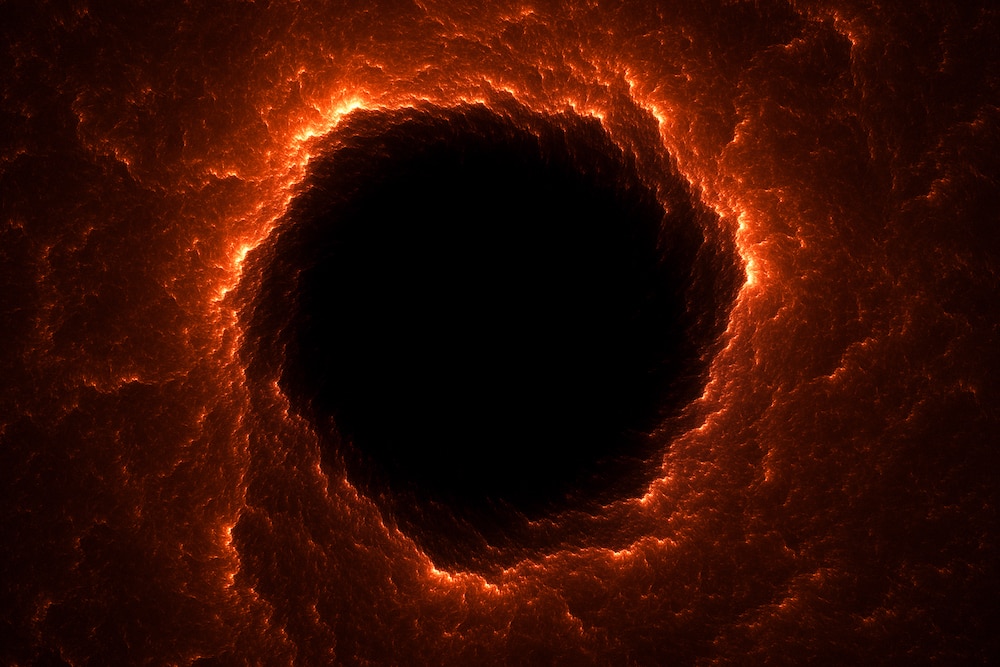Create a free profile to get unlimited access to exclusive videos, sweepstakes, and more!
Black holes lurk in literal rings of fire
If there was an Eye of Sauron in space, it would be a black hole.

Just when you thought black holes were mysterious enough, they come back with another enigma. Some of the brightest out there are all but invisible.
Black holes get their name from the impenetrable darkness beyond the event horizon, but the accretion discs surrounding them are blazing with star stuff and anything else they prey upon with their immense gravity. It was a fiery accretion disc that showed up when the M87 black hole became the first to ever be imaged. Supermassive black holes are especially ravenous. However, even the brightest accretion discs stay in the dark if they are too far away.
How can you not see something that stares through space the like a cosmic Eye of Sauron? Researcher John Weaver, DAWN Ph.D. Fellow from Cosmic Dawn Center at the Nils Bohr Institute, is looking to change that. He and colleague Keith Horne of the University of St. Andrews looked closer at accretion discs of black holes within quasars in over 9,000 galaxies observed by the Sloan Digital Sky Survey. They recently published their findings in Monthly Notices of the Royal Astronomical Society.
“As the quasar light passes through the dusty interstellar medium of its host galaxy, it becomes dimmer and redder, since small dust grains scatter blue light more than red light.” Horne told SYFY WIRE. “So we corrected each of our quasar disk spectra to make them brighter and bluer.”
Quasars (short for quasi-stellar radio source) are the young and hyperactive nuclei of emerging galaxies. They are a type of AGN or active galactic nucleus. Fueled by high-velocity gas that spirals into the gaping maw of a supermassive black hole, these objects emit gobs of radiation. It is the distance of many quasars from Earth that makes detecting them problematic. The further away an object is, wavelengths of light become longer, shifting to the infrared end of the spectrum. Wavelengths become shorter and shift to blue end of the spectrum when objects are closer.
Weaver and Horne were able to correct for dust until the blue side of the spectrum turned into a straight line and no longer appeared to turn downwards. After they were able to get a better view of the quasars, they revealed something about the black holes powering them. The accretion discs around those black holes only grew hotter the closer they ventured to the event horizon. This is stronger evidence for what was previously thought of as a possibility. Star stuff heats up from friction as it approaches its doom, but magnetic fields might really amplify that.
“We think magnetic fields link the gas in the disc to the black hole,” said Horne. “These magnetic connections can then move energy and angular momentum from the black hole to the disc, reducing the black hole's spin and heating up the gas as it spirals inward toward the black hole.”
This could mean a different way of looking at both the rates that gas and dust accumulate in accretion discs and what causes the intense brightness of quasars. Black holes might not grow so fast as they were assumed to. Weaver and Horne’s observations suggest that whatever a black hole eats accumulates at a slower rate, which means black holes also take more time to grow. There is also a potential connection between magnetic fields and quasar brightness. Magnetism may increase or decrease a black hole’s spin, causing its disc to brighten and fade.
Another thing about black holes is that their accretion discs are so efficient at converting heat to light that it beats nuclear fusion 30 times over. When a star burns energy, it fuses hydrogen atoms together, which form helium until it exhausts all its hydrogen and dies. Gas falling into a black hole unleashes gravitational energy. Its molecules spread out and crash into each other until they settle down into an accretion disc and spiral inward, waiting to be consumed. Horne looks forward to supercomputer simulations that could shed even more light on the process.
“In the accretion disk, the gas at small radius orbits faster than gas at larger radius,” he said. “Friction between the gas at different radii (caused by disk-to-disk magnetic fields) heats up the gas as it spirals in, and that gas radiates more light as its temperature increases.”
That almost makes the fires of Mordor look like hell with air conditioning.


























